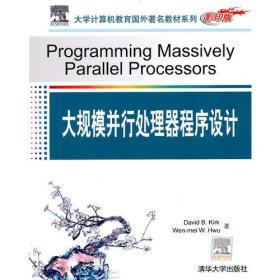
大规模并行处理器程序设计
¥ 44.18 九品
仅1件
北京昌平
认证卖家担保交易快速发货售后保障
作者[美]柯克 著
出版社清华大学出版社
出版时间2010-07
版次1
装帧平装
货号A12
上书时间2024-11-04
- 在售商品 暂无
- 平均发货时间 16小时
- 好评率 暂无
- 最新上架
商品详情
- 品相描述:九品
图书标准信息
- 作者 [美]柯克 著
- 出版社 清华大学出版社
- 出版时间 2010-07
- 版次 1
- ISBN 9787302229735
- 定价 36.00元
- 装帧 平装
- 开本 16开
- 纸张 胶版纸
- 丛书 大学计算机教育国外著名教材系列
- 【内容简介】
-
本书介绍了并行程序设计与GPU体系结构的基本概念,并详细探讨了用于构建并行程序的各种技术,用案例演示了并行程序设计的整个开发过程,即从并行计算的思想开始,直到最终实现实际且高效的并行程序。
本书特点
介绍了并行计算的思想,使得读者可以把这种问题的思考方式渗透到高性能并行计算中去。
介绍了CUDA的使用,CUDA是NVIDIA公司专门为大规模并行环境创建的一种软件开发工具。
介绍如何使用CUDA编程模式和OpenCL来获得高性能和高可靠性。 - 【目录】
-
Preface
Acknowledgments
Dedication
CHAPTER 1 INTRODUCTION
1.1 GPUs as Parallel Computers
1.2 Architecture of a Modern GPU
1.3 Why More Speed or Parallelism?
1.4 Parallel Programming Languages and Models
1.5 Overarching Goals
1.6 Organization of the Book
CHAPTER 2 HISTORY OF GPU COMPUTING
2.1 Evolution of Graphics pipelines
2.1.1 The Era of Fixed-Function Graphics Pipelines
2.1.2 Evolution of Programmable Real-Time Graphics
2.1.3 Unified Graphics and Computing Processors
2.1.4 GPGPU: An Intermediate Step
2.2 GPU Computing
2.2.1 Scalable GPUs
2.2.2 Recent Developments
2.3 Future Trends
CHAPTER 3 INTRODUCTION TO CUDA
3.1 Data Parallelism
3.2 CUDA Program Structure
3.3 A Matrix-Matrix Multiplication Example
3.4 Device Memories and Data Transfer
3.5 Kernel Functions and Threading
3.6 Summary
3.6.1 Function declarations
3.6.2 Kernel launch
3.6.3 Predefined variables
3.6.4 Runtime APl
CHAPTER 4 CUDA THREADS
4.1 CUDA Thread Organization
4.2 Using b]ockldx and threadIdx
4.3 Synchronization and Transparent Scalability
4.4 Thread Assignment
4.5 Thread Scheduling and Latency Tolerance
4.6 Summary
4.7 Exercises
CHAPTER 5 CUDATM MEMORIES
5.1 Importance of Memory Access Efficiency
5.2 CUDA Device Memory Types
5.3 A Strategy for Reducing Global Memory Traffic
5.4 Memory as a Limiting Factor to Parallelism
5.5 Summary
5.6 Exercises
CHAPTER 6 PERFORMANCE CONSIDERATIONS
6.1 More on Thread Execution
6.2 Global Memory Bandwidth
6.3 Dynamic Partitioning of SM Resources
6.4 Data Prefetching
6.5 Instruction Mix
6.6 Thread Granularity
6.7 Measured Performance and Summary
6.8 Exercises
CHAPTER 7 FLOATING POINT CONSIDERATIONS
7.1 Floating-Point Format
7.1.1 Normalized Representation of M
7.1.2 Excess Encoding of E
7.2 Representable Numbers
7.3 Special Bit Patterns and Precision
7.4 Arithmetic Accuracy and Rounding
7.5 Algorithm Considerations
7.6 Summary
7.7 Exercises
CHAPTER 8 APPLICATION CASE STUDY: ADVANCED MRI RECONSTRUCTION
8.1 Application Background
8.2 Iterative Reconstruction
8.3 Computing FHd
Step 1. Determine the Kernel Parallelism Structure
Step 2. Getting Around the Memory Bandwidth Limitation.
Step 3. Using Hardware Trigonometry Functions
Step 4. Experimental Performance Tuning
8.4 Final Evaluation
8.5 Exercises
CHAPTER 9 APPLICATION CASE STUDY: MOLECULAR VISUALIZATION AND ANALYSIS
CHAPTER 10 PARALLEL PROGRAMMING AND COMPUTATIONAL THINKING
CHAPTER 11 A BRIEF INTRODUCTION TO OPENCLTM
CHAPTER 12 CONCLUSION AND\\\'FuTuRE OUTLOOK
APPENDIX A MATRIX MULTIPLICATION HOST-ONLY VERSION SOURCE CODE
APPENDIX B GPU COMPUTE CAPABILITIES
Index
点击展开
点击收起
相关推荐
— 没有更多了 —

















以下为对购买帮助不大的评价